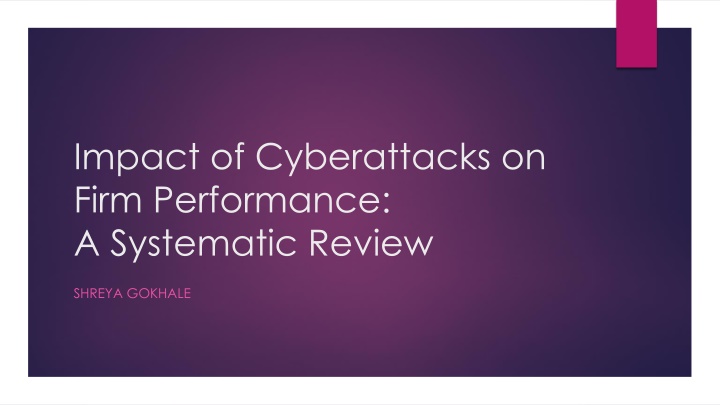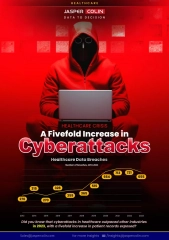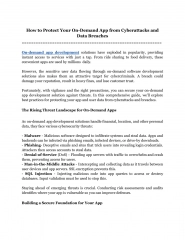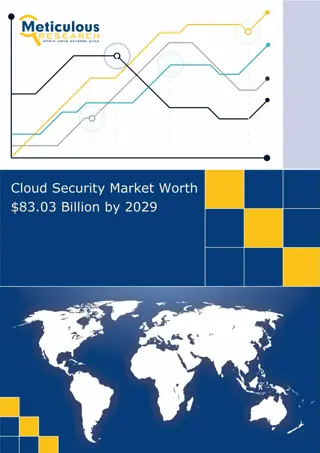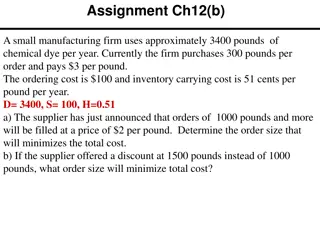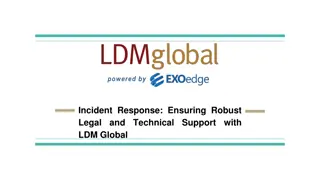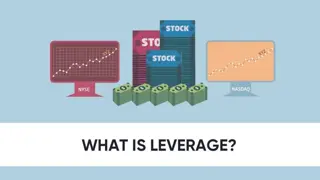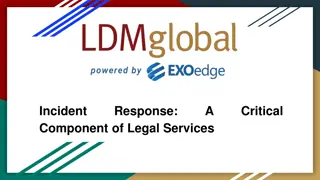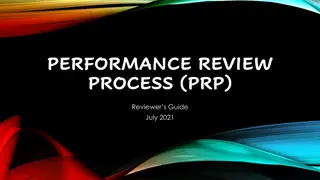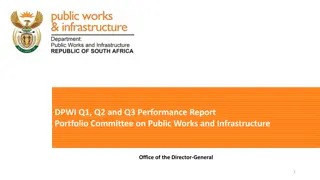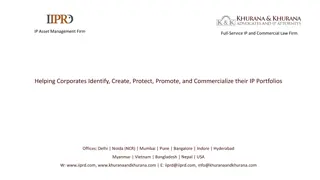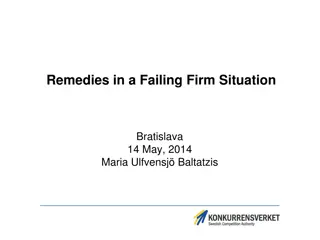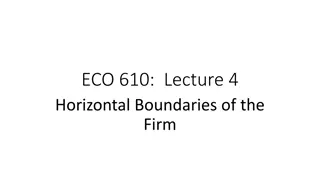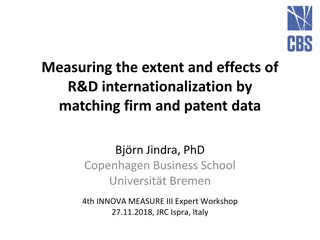Impact of Cyberattacks on Firm Performance: A Review of Findings
Significant research has been conducted on the impact of cyberattacks on organizations' market value, yielding inconsistent findings. This systematic review delves into factors influencing stock market performance outcomes post-cyberattack events, offering practical insights for enhancing cybersecurity strategies.
Download Presentation

Please find below an Image/Link to download the presentation.
The content on the website is provided AS IS for your information and personal use only. It may not be sold, licensed, or shared on other websites without obtaining consent from the author.If you encounter any issues during the download, it is possible that the publisher has removed the file from their server.
You are allowed to download the files provided on this website for personal or commercial use, subject to the condition that they are used lawfully. All files are the property of their respective owners.
The content on the website is provided AS IS for your information and personal use only. It may not be sold, licensed, or shared on other websites without obtaining consent from the author.
E N D
Presentation Transcript
Impact of Cyberattacks on Firm Performance: A Systematic Review SHREYA GOKHALE
Agenda Introduction Algorithm Analysis Synthesis Future Research
Impact of Cyberattacks Significant research on impact of cyberattacks on organizations market value. Inconsistent findings, ranging from long-term negative impact to only short-term negative impact to absence of significant impact. Research Question: What factors drive the different stock market performance outcomes resulting from cyberattack events? Practical Significance: Understanding these factors can provide insights into the ways to engage companies to invest in developing their cybersecurity strategies.
Algorithm for Collection of Articles Searched articles on Google Scholar Published in or after 2000 using various combinations of key words and phrases such as cyber , attack , breach , leakage , data , firm , performance , market value , stock , returns Focussed on journals With impact factor 1 according to Journal Citation Reports or Web of Science From areas of finance, marketing, accounting, management, economics, information systems, computers and security Included relevant articles from SSRN, NBER, HBR Included articles from conferences, books, or journals with unavailable impact factor with Google Scholar citations 100 Removed irrelevant articles detected by reading abstract and skimming the article
ANALYSIS OF SELECTED ARTICLES
Selected Set of Articles for Review Journal Categories Total 42 articles selected 36 journal articles 1 5 3 1 SSRN article 2 6 1 NBER article (working paper) 3 1 HBR article 3 5 3 articles from conferences/books/journals with citations 100 8 Finance Accounting Marketing Economics Information Systems Management Computer and Security Technology Service Research
Analysis by Impact Factor and Citations Analyzing Articles by Journal Impact Factor Analyzing Articles by Citations 14 14 12 12 10 10 8 8 6 6 4 4 2 2 0 0 [1,4) [4,7) [7,10) [10,13) <10 [10,50] [50,100] [100,500] [500,1000] >1000
Analysis by Time Analyzing Articles by Year 6 5 4 3 2 1 0 2003 2004 2005 2006 2007 2008 2009 2010 2011 2012 2013 2014 2015 2016 2017 2018 2019 2020 2021 2022 2023
Dependent Variables Used All except 4 articles, all use Cumulative Abnormal Returns (CAR) as the DV Other stock market measures used as DV include: Bid-ask spread Trading volume Stock market volatility Stock price Some articles use financial measures as DV in addition to stock market measures: ROA, ROE, ROS, COGS/Sales, Sales growth, Revenue, Cash flows, Leverage, Investments in Capital, R&D, and Acquisitions
Analysis by Impact of Cyberattacks on Stock Returns Majority of the articles find long-term negative impact. Analyzing Articles by Impact of Cyberattack on Market Value Almost a quarter of the articles find no significant impact 10, 24% 17, 40% 60% articles find either short-term or no impact of cyberattacks on stock market performance. 15, 36% Worrying since firms could lose incentives to invest in cybersecurity Long-term negative impact Short-term negative impact No significant Impact
Articles Finding Long-Term Negative Impact Paper Breach Data Source Period of Analysis Dependent Variable Relationship found Moderators Effect of moderators Cavusoglu et al. (2004) Lexis Nexis, technology portals CNET and ZDNET 1996-2001 Cumulative abnormal return Decreased Firm size, Internet vs conventional firms, breach type Internet firms and smaller firms experienced larger return drop Gatzlaff and McCulloug h (2010) Privacy Rights Clearinghouse (PRC) 2005-2006 Cumulative abnormal return Decreased Firm size (market capitalization), expected security adherence, refusal to provide information, growth opportunities (market-to- book), previous breach victim, breach at subsidiary firm, breach type Firms refusing response to data breach inquiries, smaller firms, and firms with higher growth opportunities experienced larger return drop. Parent firms experienced smaller return drops after breach at a subsidiary firm. Goldstein et al. (2011) Financial Institutions Risk Scenario Trends (FIRST), by Algorithmics Inc. 1985 to 2009 Cumulative abnormal return Decreased more for function-related breaches as compared to data- related breaches Breach affecting availability, breach affecting integrity Function-related events affecting availability rather than integrity experienced larger drops as compared to data-related breaches
Articles Finding Short-Term Negative Impact Paper Breach Data Source Period of Analysis Dependent Variable Relationship found Moderators Effect of moderators Acquisti et al. (2006) Lexis-Nexis, ProQuest 2000-2006 Cumulative abnormal return Decreased in short- term Breach reported in national media vs local and industry outlets, number of individuals affected in the breach, firm size (stock value), cause of breach, subject of data disclosed Smaller firms and firms with breaches that affected more than 100,000 subjects experienced larger return drops. McShane and Nguyen (2020) Advisen Ltd. Company 2007-2016 Cumulative abnormal return Decreased in short- term Type of cyber event (DOS, phishing, unauthorized access of customer data), involvement of insider, type of data stolen, type of industry Firms facing breaches causing immediate business interruption losses, involving insiders, involving loss of credit card and personal data experienced larger return drop. Firms in retail and service industry experienced larger return drops. Goel and Shawky (2009) Lexis-Nexis 2004-2008 Cumulative abnormal return Decreased in short- term NA NA
Articles Finding No Negative Impact Paper Breach Data Source Period of Analysis Dependent Variable Relationship found Moderators Effect of moderators Kannan et al. (2007) Wall Street Journal, the New York Times, ZDNet, CNET 1997-2003 Cumulative abnormal return Did not significantly decrease in either short-term or long- term Breach announced in dot-com era, firm size, breach affecting confidentiality vs integrity vs availability Firms facing breaching in dot- com era experienced larger return drops only in short-term as compared to those facing breaches in dot-com-bust era. Campbell et al. (2003) Wall Street Journal, New York Times, Washington Post, Financial Times, and USA Today 1995-2000 Cumulative abnormal return Decreased for breaches involving unauthorized access to confidential data, did not decrease for breaches not involving confidential data NA NA Juma h and Alnsour (2020) PrivacyRights.org and Information- IsBeautiful.net 2005-2017 Change in ROA, ROE, stock prices ROA, ROE decreased, stock prices did not show significant relationship NA NA
Organizational Factors Contributing to Negative Long-Term Impact Decreasing Negative Long-Term Impact Smaller firms in terms of assets, market capitalization Investment in technology, cybersecurity, staff training Higher growth opportunities or rapidly growing firms Firms showing high degree of transparency in the collection and use of personal information Firms giving users higher degree of control over selection of information that can be shared Being the parent firm of a subsidiary that was breached Higher leverage, operating profit, Tobin s Q, market-to-book ratio Being previous breach victim Refusal to respond to data breach inquiries Being rival of a severely breached firm Greater social media exposure or media visibility at the time of the data breach incident Firms providing immediate notification regarding efforts to control the amount of information disclosed and compensation for affected individuals. Sector: Consumer goods, communication Firms from highly competitive markets Sector: Financial, technology, retail, service, -
Cyberattack-related Factors Contributing to Negative Long-Term Impact Decreasing Negative Long-Term Impact Greater severity in terms of number of records leaked or manipulated ( 100,000 records affected) Breaches affecting confidentiality (leading to loss of personally identifiable or sensitive information of customers/employees such as SSN, credit card details, bank account details, health information) Breached affecting availability as opposed to integrity Attack executed by external malicious actor as opposed to an insider No leakage of confidential information regarding customers Being the parent firm of a subsidiary that was breached Breaches leading to immediate business or functional disruption (such as DOS attack) as opposed to loss of data Breached resulting from phishing Announcing data breach strategically, on days with higher news pressure Cyberattack disclosed as soon as it was detected by the firm Breached involving lost devices - Greater time between occurrence and public disclosure of the cyberattack event. -
FUTURE RESEARCH
Future Research Ideas Research on conditions under which a specific firm suffering from a specific breach is likely to face a long- term/short-term/ no impact.
Future Research Ideas For conditions not likely to cause a long-term negative impact: investigate other firm outcomes that are significantly affected after cyberattacks suggest incentives/policies that can drive such firms to invest in cybersecurity.
THANK YOU COMMENTS/QUESTIONS?
